Ricoh GXR: Camera Unit A16-24-85
Introduction the the A16 24-85 Camera Unit | Photos of the Camera Unit Attached to the Body | Experiences | Conclusions | Links
Archive
On this page, I collect information about the Ricoh GXR A16 24-85 camera unit, the latest camera unit, also called lensor or module, for the GXR that I purchased (and that was released...).
Introduction the the A16 24-85 Camera Unit
The A16 24-85 camera unit is the first (and regrettably, last) one to contain a 16 MP APS-C size sensor (CMOS, total pixels: approx. 16.5 million, effective pixels approx. 16.2 million). It is a zoom module with a 3.5x zoom range and a focal length between 15.7 mm and 55.5 mm, which is equivalent to 24-83.5 mm (officially it's 24-85 mm). The unit corresponds to a "standard" zoom lens for a (D)SLR, however with a more extreme wide angle. It does not have a macro mode, but allows you to shoot from a closest distance of 25 cm. The lens has neither a focus nor a zoom ring. There are also no depth of field indicators on the lens body, but depth of field information is provided in the viewfinder or on the LCD screen when focusing manually. Also note that A12/A16 camera units do not incorporate a vibration correction (also called "anti-shake" correction).
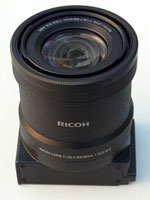 |
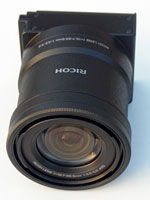 |
Photo: Ricoh Lens A16 24-85 mm equiv. f/3.5-5.5
Accessories for the unit include the lens cap LC-3, which can be left on the lens all the time, and the lens hood LH-2, which regrettably cannot be used together.
Finally, I should add that this camera unit is able to capture videos in HD 720p format - not stellar, these days...
Photos of the Camera Unit Attached to the Body
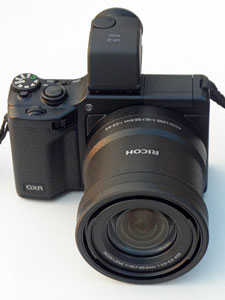 |
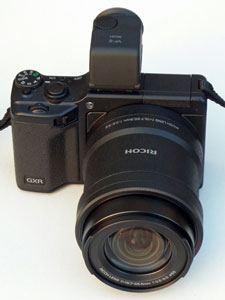 |
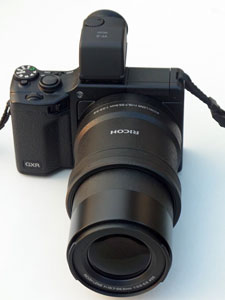 |
Photos: Body with A16 24-85 camera unit attached - "off" (left),"on" (wide; center), "on" (tele; right)
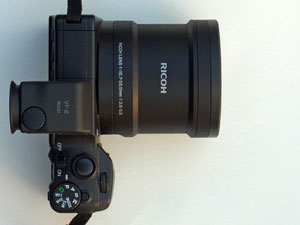 |
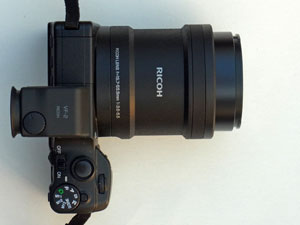 |
Photos: Top view of body with A16 24-85 camera unit attached - "off" (about 7cm long; left) and "on" (about 8.7 cm long; right)
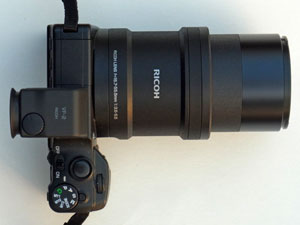 |
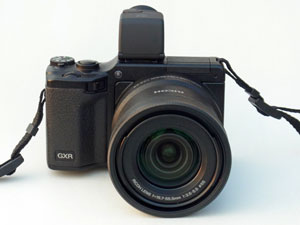 |
Photos: Top view of body with A16 24-85 camera unit attached - "on" zoomed to 85mm (about 11.9 cm long; left); front view of the body with A16 24-85 camera unit attached - "off" (right)
Experiences
The image quality of this camera unit is comparable to that of an APS-C DSLR. Particularly the sensor is very good (including its hugh ISO performance), but according to Sean Reid, the lens is only mediocre. Thanks to the missing AA filter, the lens is very sharp at the center, and overall images look crisp on a computer monitor. For sample photos, see pages A16 24-85 Samples (Nature Shots) and A16 24-85 Photos (Haute Loire, France).
However, like reviewer Sean Reid, I found soft corners (and maybe soft edges), which seemed to indicate that my sample was decentered. I present examples of this issue on this site. I sent my camera unit to the CONVAIR repair center in Pirmasens, Germany, for adjustment. But I was not satisfied with the results (see (page 1 and page 2). Finally, Ricoh replaced the unit, for which I am very grateful, but the new unit was not a real improvement - it just shifted the issue to other corners (see here)...
While the zoom range is limited (24 to 85 mm equiv.), it is not as limited as the one of the Leica X Vario. For zoom samples, see page Zoom Comparisons.
As mentioned above, the A16 camera unit lacks a macro mode, but allows you to shoot from a closest distance of 25 cm, which makes it quite useful for close-up shots, particularly when using tele. For example images, see page Closeup Samples.
The A16 camera unit offers a dynamic range correction function, which I found quite useful in some cases (for example, for extremely backlit scenes). See page Dynamic Range Compensation Comparisons for sample images.
Autofocus performance of this camera unit is not stellar, but seems to be comparable to the A12-50 unit. In my first tests, I could not find huge differences between wide and tele focal lengths. However, I found instances, where the autofocus indicated "success" but missed the target. This happened when I shot close ups - even spot autofocus and "pin point" spot autofocus did not improve matters.
And here is another "issue" - you may experience it as well or not, depending on how you hold the camera. Due to the wider diameter of the lens base, there is no room left to give my left ring finger a rest on the camera body. With the A12-50 camera unit, there is still some space left for this (see the photos below).
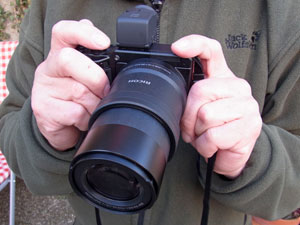 |
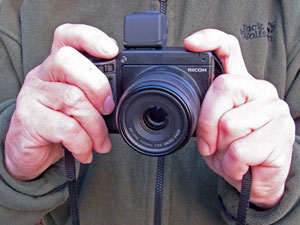 |
Photos: No room left for my ring finger on the body with the zoom (left); at least some room for the ring finger with the A12-50 (right)
The A16 24-84 unit weighs about 350 grams, that is, 90 grams more than the A12-50 camera unit. While the unit feels big, particularly when zoomed to tele (it extends for nearly 12 cm, see the photos below), it does not feel heavy. This is probably due to the use of plastic (nearly) all over. Some people will complain about this, but I don't mind (my full-metal rangefinder Zeiss lenses for the M-mount expansion unit feel really heavy...).
The new two-way level indicator will probably need some time to get used to (see photos below):
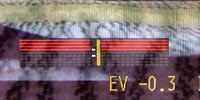 |
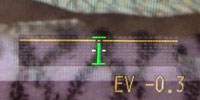 |
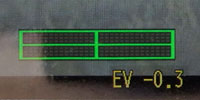 |
Photos: The new two-way level indicator
All in all, despite some shortcomings, the A16 24-85 camera unit has become my favorite camera unit from summer 2012 to spring 2013 (then the Leica X Vario took over...), because of its versatiliy. I am only missing a macro mode and a somewhat larger zoom range in the tele region.
Conclusions
I mentioned that the the A16 unit has an image quality comparable to DSLRs with an APS-C sensor. However, I encountered issues with corner softness that I did not find tolerable - in the end the unit was exchanged after a repair, however, without much improvement. For details, see pages:
- Corner Softness Samples
- Corner Softness Samples (after Adjustment - 1)
- Corner Softness Samples (after Adjustment - 2)
- Corner Softness Samples (New Lens)
The lens also shows fairly strong distortion at the wide end. For details see page Distortion Samples (Wide Angle). It is quite useful for taking close-up shots. For details see page Closeup Samples. While the zoom range is limited, it is not as limited as the one of the Leica X Vario. For zoom samples, see page Zoom Comparisons.
Because of its versatility, the A16 24-85 camera unit has become my favorite unit from summer 2012 to spring 2013 - then the Leica X Vario took over....
Links
Ricoh Links
- Technical data: ricoh.com/r_dc/gxr/specs.html#15
- Description: ricoh.com/r_dc/gxr/unit6.html
Links to Pages on this Site
- My Equipment
- ISO Comparisons A16 24-85
- ISO Comparisons A16 24-85 (Night Shots)
- Zoom Comparisons
- Dynamic Range Compensation Comparisons
- Closeup Samples
- Distortion Samples (Wide Angle)
- Corner Softness Samples
- Corner Softness Samples (after Adjustment - 1)
- Corner Softness Samples (after Adjustment - 2)
- Corner Softness Samples (New Lens)
- A16 24-85 Samples (Nature Shots)
- A16 24-85 Photos (Haute Loire, France)
- Comparisons with A12-50 (Nature Shots)
- Comparisons with Leica X Vario
Ricoh GXR A16 Versus Leica X Vario
- Technical Data Comparison
- Technical and Functional Comparison
- Size and Weight Comparisons
- Manual Focus Comparison
- Comparisons with Leica X Vario
| 19.11.2020 |